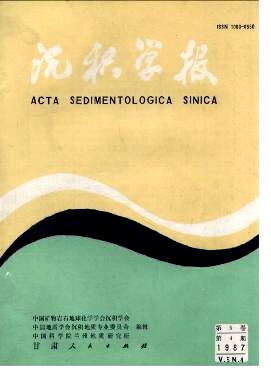SEDIMENTARY ENVIIRONMENT AND MODEL OF THE LATE PERMIAN IN LONGEMENSHAN REGION, SICHUAN PROVINCE
- Received Date: 1985-11-22
- Publish Date: 1987-12-10
Abstract: During the latest Permian(Changsingian), the Longmenshan region was situated ia the northwestern margin of the South China Sea, it belonged to a transitional zone between Yangtze Platform and Songpan-Garze Geosyncline. The fault basin of the Longmenshan zone underwent continuously submerge due to the influence of the vast Varictan movement and formed mainly the deeper water marginal sea trough, with NNE trend. The sediment is composed of mixed deposition by the carbonate and mud-siliceous, rare terrigenous clastic, partly contain abundant organic materials(bituminization) and pyrite, with horizontal bedding, rhythm bedding, knotty nodular and sheet crack sturctures etc. The biota is represented by the develop of planktonic fauans, such as ammonoids radiolariads, conodonts and siliceous facies brachipoda etc. According tothe type of rocks, sedimentary structure and biological assemblages etc.the latest Permian sedimentary facies can be divided into the following: 1 Deep water shelf facies The type of rocks is composed of dark grey thin to medium bedded micrite and siliceous micrits intercalated with calcareous shale and containing. They are a few of organic materials, pyrite and chert bands or blocks, and display horizontal bedding, lenticular bedding and knotty structure. The biota is represented by benthnic, plankonic and epiplanktonic mixed faunas, such as radiolarians, conodonts, siliceous facies brachiopods with thin-shelled and a few of thick-shelled brachoipods, solitary corals, foraminif ers etc. This facies may be considered as a transitional zone between the platform and the basin, in which the sea water was deeper, and the circulation of water current was moderate. It was formed in the slightly oxidizing to slightly reduction condition, and in the environment changed from lower energy to medium energy. 2 Slope facies The sediments are dark-gray to gray-black thin-bedded mud -bearing siliceous rocks, siliceous micrite intercalated with carbonaceous shale or black shale and characterized by distinct horizontal bedding and rhythm bedding as well as partly with intraformational slump-folds and faulted sturcture. They contain abundant organic materials(partly bituminizaed) and pyrite nodular. Fossils are rather monotonic and less in quantity in the facies, chiefly including planktonic and epiplanktonic faunas, such as ammonoids, conodonts, and some hemi-planktonic or benthonic faunas, such as non-fusuline foraminifers etc. This facies is proved to be slope zone between the shelf and the basin, in which the sea water was deeper and with restricted circulation and reduction condition. 3 Basin(or sea trough) facies It includs 3 zones of seeimentary facies:( 1 ) Lag zone of basin This facies is composed of gray-black thin-bedded mud-bearing siliceous rocks, carbonaceous radiolarites, siliceous micrite intercalated with carbonaceous shale. They are rich in organic materials(bituminization) and pyrite with horizontal bedding and rhythm bedding. The biota is characterized by abundant plankonic faunas such as ammonoids, conodonts and radiolarians. This facies is represented by the lag basin of the deep water, quite of water current and the reducing condition.(2 ) Rise zone of basin The siliceous micrite intercalated with calcareous shale is mainly the rock type, which is dark grey, thin to medium-bedded, with rhythm bedding. The faunas assemblage is composed of planktonic, epiplanktonic and a few benthonic faunas such as ammonoids conodonts and foraminifers etc. According to the characters of lithofacies and biofacies, it was a partly rise region of basin, in which the sea water was shallower with medium energy and the circulation of water current was better.( 3 ) Flowage zone of basin The zone is made up of dark grey thin-bedded siliceous radiolarite, siliceous micrite intercalate with montmorillonite-illite irregularly mixed layer clay rock. Some clay rock was formed under marine conditions by volcanic ash. It possesses rhythm bedding, knotty nodular and sheet cracks structures etc. The bio
| Citation: | Jin Ruogu. SEDIMENTARY ENVIIRONMENT AND MODEL OF THE LATE PERMIAN IN LONGEMENSHAN REGION, SICHUAN PROVINCE[J]. Acta Sedimentologica Sinica, 1987, 5(4): 78-89. |






 DownLoad:
DownLoad: